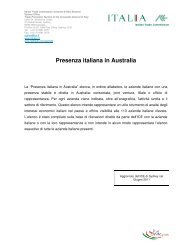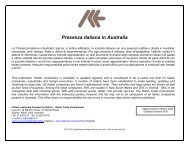Price Determination in the Australian Food Industry A Report
Price Determination in the Australian Food Industry A Report
Price Determination in the Australian Food Industry A Report
You also want an ePaper? Increase the reach of your titles
YUMPU automatically turns print PDFs into web optimized ePapers that Google loves.
Figure 42. Leg of lamb, supply cha<strong>in</strong> map<br />
Farmer<br />
Primary<br />
Process<br />
Secondary<br />
Process<br />
Market Logistics<br />
Retail<br />
Brand Ownership/<br />
Management<br />
saleyards/direct consignment<br />
transporter<br />
Broker/agent<br />
<strong>Food</strong> Service<br />
Feedlot<br />
Breed<strong>in</strong>g<br />
Property<br />
Abattoir<br />
Bone Out<br />
Wholesalers<br />
Butcher<br />
Domestic<br />
Consumer<br />
• Closely aligned with<br />
wool <strong>in</strong>dustry.<br />
• 43,700 farms with over<br />
200 sheep. 39%<br />
receive <strong>in</strong>come from<br />
prime lambs, prime<br />
lamb ma<strong>in</strong>ly NSW and<br />
Victoria.<br />
• <strong>Australian</strong> sheep meat<br />
production has a gross<br />
value of production of<br />
around $1.5 billion<br />
annually.<br />
• Often feedlots and<br />
breed<strong>in</strong>g properties<br />
are collocated and<br />
operate as a s<strong>in</strong>gle<br />
enterprise.<br />
• 2002 lamb and mutton<br />
production was 322,000t<br />
and 297,000t respectively.<br />
• 29% lamb and 55% mutton<br />
was exported <strong>in</strong> 2002.<br />
• Drought, trade policy and<br />
world flock numbers have<br />
major effects on price.<br />
• A small number of<br />
producers are market<strong>in</strong>g<br />
<strong>the</strong>ir own lamb brands. It is<br />
expected that this will<br />
<strong>in</strong>crease <strong>in</strong> popularity as<br />
shown by o<strong>the</strong>r red meat<br />
<strong>in</strong>dustries.<br />
Cha<strong>in</strong> Retailer<br />
• Fresh lamb is sold through<br />
major supermarket cha<strong>in</strong>s<br />
and butcher shops.<br />
LAMB – ANALYSIS OF PRICING<br />
Retail versus farmgate overview<br />
As discussed above, <strong>the</strong>re are dangers <strong>in</strong> simple comparisons between farmgate and retail prices.<br />
Figure 43. Farmgate OTH, wholesale and retail lamb trends, cents/kg, 1998–2003<br />
cents/kg<br />
1600<br />
1400<br />
1200<br />
1000<br />
800<br />
600<br />
400.<br />
200<br />
0<br />
forequater chops retail<br />
forequarter wholesale<br />
The approach taken<br />
legs whole sale<br />
lo<strong>in</strong> chops retail<br />
leg retail<br />
Feb 1998 quarterly May 2003<br />
carcass wholesale<br />
average OTH<br />
Assumptions used <strong>in</strong> this analysis are:<br />
• OTH sales have been based on 18–20kg with a 2–4 fat score;<br />
• wholesale prices for carcass, forequarters and legs are based upon NLRS wholesale market data<br />
from <strong>the</strong> Sydney wholesale market us<strong>in</strong>g 18–20kg carcass with a 3 fat score; and<br />
• retail prices for lo<strong>in</strong> chops, legs and forequarter chops have been based on ABS surveyed data.<br />
<strong>Price</strong> <strong>Determ<strong>in</strong>ation</strong> <strong>in</strong> <strong>the</strong> <strong>Australian</strong> <strong>Food</strong> <strong>Industry</strong> A <strong>Report</strong><br />
47







